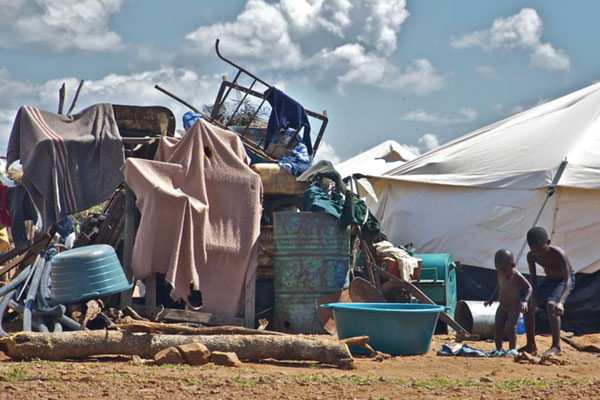
WHEN the 1,8 billion cubic metre Tugwi-Mukosi Dam, the largest inland water reservoir in the country, was completed in December 2016, many thought the perennial woes of the drought-prone Masvingo province had finally come to an end.
BY TATENDA CHITAGU

Previously known as Tokwe-Mukosi, the dam was renamed Tugwi-Mukosi in March this year. The new name is derived from Tugwi and Mukosi, the two rivers that feed into the dam. Tugwi is a Shona name for a “flooded river”.
Yet, more than a year-and-a-half after its completion, water from the $255 million project remains unused as government is yet to come up with a masterplan to start harnessing the resource for irrigation purposes in vast swathes of arable land downstream.
The much-awaited dam, mooted in the 1960s by the Rhodesian government, went through a stop-start process from 1998 until it was completed at a cost of $300 million on December 9, 2016 by Italian contractor, Salim Impregillo.
Former President Robert Mugabe officially commissioned the dam on May 18 2017 and promised Masvingo province heaven on earth owing to the prospective benefits from the dam — but he was probably just churning out the same old empty rhetoric of the anticipated economic spin-offs from the project.
Apart from being touted for its potential to unlock an array of business opportunities in the tourism, hospitality, retail and transport sectors, among others, Tugwi-Mukosi has the capacity to irrigate 26 000 hactres of land and to generate 15MW of hydro-electricity.
An animal park and conservancy is also set to be established in the dam’s confines, but up to now, it remains a pie in the sky.
- Chamisa under fire over US$120K donation
- Mavhunga puts DeMbare into Chibuku quarterfinals
- Pension funds bet on Cabora Bassa oilfields
- Councils defy govt fire tender directive
Keep Reading
All that glittering water has, so far, not been turned into gold.
Even the proposed ethanol plant by controversial businessman, Billy Rautenbech, in Nuanetsi ranch, where 18 000 flood villagers displaced by the dam construction are housed, fell by the wayside due to political bickering and some are yet to be compensated.
Save for some few fish planted in the dam under command aquaculture, Masvingo has little, if anything, to show for playing host to the country’s biggest inland dam, which surpassed Lake Mutirikwi, also housed in the province, in size.
“This is a case of misplaced priorities on the government, which is failing to move with speed to exploit the dam’s water. Last year, the government spent millions of dollars on command agriculture, without pumping money into irrigation infrastructure to harness water from the dam and avert hunger. Masvingo province can produce enough to feed the whole country if the dam is put to full use,” said a water conservation and sustainability expert who declined to be named for professional reasons.
“We can also produce a lot of sugar for export and domestic consumption while also reviving the beef industry from cane feeds, as well as produce ethanol.”
President Emmerson Mnangagwa, who took over power from Mugabe after last November’s military coup following internal Zanu PF power struggles, also promised to put the dam to good use.
“Here in Masvingo, we have the Tugwi-Mukosi Dam which will help our agriculture and tourism sector. We want villagers displaced by the dam construction to benefit from the water, so we will create irrigation schemes where they will grow sugarcane,” Mnangagwa said at a campaign rally in Masvingo late June this year.
Masvingo Provincial Affairs minister Josaya Hungwe told NewsDay that they will be making full use of the dam very soon as the project was now complete.
“It’s now complete (the dam project) and we will be making full use of the water. We will be starting to reap the benefits from the dam soon.”
Hungwe urged displaced villagers to apply to be sugarcane outgrowers on irrigation schemes proposed downstream so that they could also benefit from the project that saw them moved from their traditional and ancestral homes.
Tugwi-Mukosi was billed as a permanent panacea to recurrent food security woes in drought-prone Masvingo province because of its potential to irrigate the arid southern parts of the province.
Besides irrigation, the dam also has the potential to spur tourism and generate electricity through a mini-hydro power plant that would generate 15 megawatts.
The dam’s flooding, which occurred in February 2014 after the torrential rainfall pounded the Masvingo province, was classified as a national disaster. It caused the dam’s wall to partially collapse, leaving over 1 500 families homeless. The victims were subsequently relocated to Chingwizi transit camp in Mwenezi.
Around 4 500 villagers living along the flood basin of the dam were evacuated after water seeped through cracks in the dam wall, flooding the river that flows directly towards the villages. An estimated 2 500 households who lived upstream of the dam were relocated to Chingwizi, Chisase and Masangula in Nuanetsi Ranch in Mwenezi district.
The flood victims grappled with food shortages as government and the door community were failing to avail an average of 123 tonnes of maize needed to feed them monthly.











